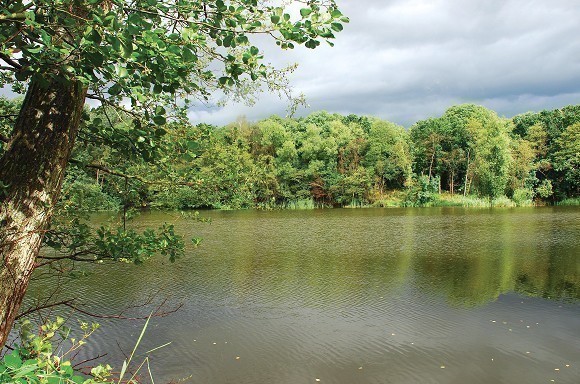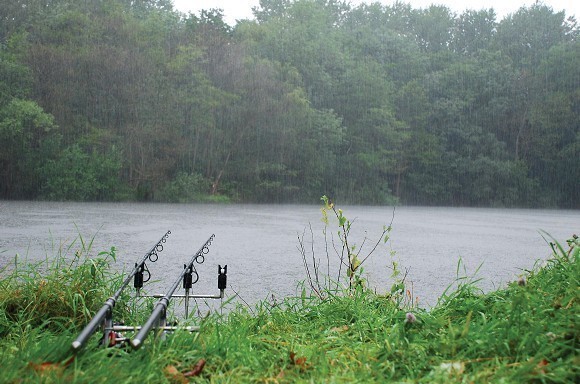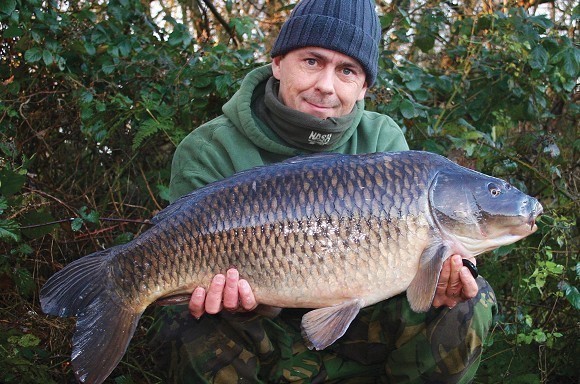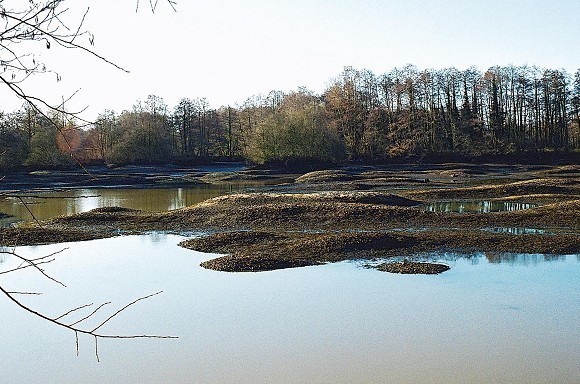
Gravel bars and silt spots explained
Fish a gravel pit? Fish a lake with silt? Read this...
He’s fished them for over 30 years. He’s caught from nearly every lake in the Black Water Valley resulting in common, mirror and leather carp to over forty-pounds. He’s also seen some of the lakes along his way being dug and seen the famous Yateley Copse, Pads and North lakes being drained, so who better to ask about gravel pit carping than our very own Nigel Sharp.
“On lakes that are heavily littered with gravel areas/bars (i.e. the world famous Sandhurst Lake) what areas are you looking for?”
“Since I started fishing, which is a fair while ago now, I pretty much always fished every type of gravel pit from maximum extractions to line dragged ones. Funny you should give Sandhurst as an example, as for the many anglers that have cast a marker rod out in that lake, they will think the same as I do, that if CEMEX had known how much gravel was still on its bed, they would have wanted to re-work it before they’d sold it on.
“Getting back to your question. On these types of water, which there are a fair few of in the Black Water Valley, I would spend my time finding the slightly deeper areas or gullies as we call them and hopefully find some firm silt pockets or finer shingle rather than rough gravel. Hopefully once I have found a few of these I tend to try and work out if the gullies travel along the lake and make up roadways for the carp to move along. Pit 1 at Frimley is a great example of this and all its major bars run across the lake in the same direction and some even formed the islands.”
“Are there areas on gravel bars you prefer to fish over others? I.e. are some too obvious?”
“That depends on the shape of the bar or feature really. If it’s say an oval-shaped bar in deep open water, I would tend to find the end of the bar and place my rigs on the base of the slope at the end which I felt the fish would be approaching from. Again, this would change slightly if it was in a weedy water and I was forced to fish on the feature due to weed growth, but again, I would tend to place my baits hard up against the edge of the weed. The only time I would fish on a bar’s summit would be if I was again in a deep weedy water and it was a fairly flat topped bar or plateau. The only time I would favour baits the top of a bar/plateau is if my freebies wouldn’t tend to roll or waft down to the base and would stay where I put them. These high points of features are also good spots to fish during high-pressure when the fish are spending time in the upper layers rather than the gullies.
“The common approach is to always fish at the back of the bar. Do you prefer this way or do you fish at the front so you get better line lay? Or, do you feel you’ll get better line lay fishing to the back?”
“Again, this is all down to the shape of the feature I’m fishing to. On a pit that is line-dragged, the bars can run long distances so you are sometimes forced to fish over them, as the fish won’t be travelling along the nearside. On a shorter bar or hump in open water I would tend to fish the nearside especially if I wanted to fish a slack line. These features don’t tend to dictate the carp’s movements, so I don’t always feel the need to fish over them like I would on some other features. However, if I were going to, I would more often than not fish a fairly tight line, as it would undoubtedly help with line concealment by pinning it down against the feature.”
“Most anglers today whack out the marker, get that ‘tap, tap, tap’ feeling and pop the float up. What do you do differently to that?”
“Not a great deal, but I do tend to explore the bar a bit more than just think ‘that’s the spot’ and chuck a rig next to it. Quiet often I will keep dragging the float back a few inches and check the depths to see how pronounced the bar is. I also tend to bring another rod into play and cast around the existing marker to see how far left and right the bar travels. Of course once I am familiar with a feature, I will just do the ‘pull back and tap, tap routine’ and then just use the float as a reference point.”
“When locating an area to fish, how much does the weather come into play in choosing your spot?”
“With all aspects of carp fishing the weather always comes into it, but as far as choosing which spots to fish, if it was a still sunny day with high-pressure I would be tempted to fish on shallow high points like I talked about earlier. During low-pressures and windy days I would tend to fish the gullies or deeper areas of a lake.”
“For most of your feature finding work you seem to just use one marker rod. Wouldn’t two be better and easier? Also, how do you build up a picture of the lakebed in your mind – and how quick can you do this – three, four, five casts?”
“Oops! I think I might have already answered part of this question earlier, but two is definitely an easier way of learning a feature faster. As far as how many casts, I find the more the better in the early stages of learning a lake. Obviously if I’m on fish it’s a case of keeping the disturbance down to a minimum and getting a rig presented quickly and effectively without killing the swim by thrashing it to a foam with a marker float.”
“On some lakes you have your ‘obvious’ features – i.e. a gap between two islands. Have you found these tend to attract the smaller fish in the lake?”
“The problem with obvious features is they do tend to attract angling pressure. I have noticed on a number of waters with these areas that they might do more bites than the rest of the lake due to the amount of bait and angling pressure, but more often than not they do tend to be the shoal fish and much smaller ones. The sunken island in front of The Double Boards on Frimley’s Pit 3 is a prime example of this. Not to say you won’t catch the big ’uns from that swim because they do occasionally get caught from there, but more often than not they’ll be taken from slightly different areas to the norm.”
“What areas attract you when targeting the larger residents of the lake?”
“The areas that attract me are normally the ones that have past form of doing the fish that I am after, but from experience I always seem to bag the big one I’m after from deep areas/gullies near to open water features. Again, like the last question, you might catch or stalk a few more round the edges, but most of my big ’uns have come from open water areas. The thing with fishing in the edge, I might only get one chance of a target fish, so it’s best to have more than one option over the course of a year, rather than be just a one trick pony. Not to say I wouldn’t have a go if the chance arose!”
“Lets talk about your experiences over at ultra pressured Road Lake now. You mentioned before about a particular gravel spot that produced plenty of fish for you – what attracted you to this spot?”
“That spot was one of these middle of the pond spots we call, ‘The Google Earth Spot’. Like I wrote in my book, I ended up drawing The Launch Swim on the open week and that swim controls the open water and ‘The Google Earth Spot’. Other than catching straight from the off what also kept me interested in that area for a few more weeks was the fact that a mate of mine called Dean Duke had done well from that swim a few years previously when the small lake was quite busy and the angling pressure seemed to push the fish out in front of him. Dean being no fool soon worked this pattern out and he milked it for every bite that he could that year and ended up as top rod.
I couldn’t ignore that bit of lake history and based a similar attack around Dean’s past results. Luckily for me, at the beginning of that season the weed hadn’t hit the surface so the fish were seeking sanctuary in open water around ‘The Google Earth Spot’ and this played straight in to my hands at the time. It was all about lake history and watercraft really.”
“You’ve talked about fishing just into the silt behind a gravel or hard spot before, but how much into the silt will you fish – a foot back, two foot back, etc., etc. How important do you think this is”
“I like to think the last few feet of my end game is on the deck, so if I can guarantee that at least a carp’s length is on the deck, that’s how far past a bar I will place my rig. Again, this all depends on what sort of silt it is and how much weed is about, obviously if the silt’s stinking and the weed’s bad, I will be forced to fish right on the edge of the gravel.”
“During a five-day trip to the world famous Redmire Pool, you battered them from silty areas. These areas were picked through a combination of what appeared to be their patrol route and where you saw them fizzing. But what if you haven’t seen any of that action – how would you have gone about finding a spot in the silty lake?”
“Basically I’d use the usual approach of flicking about with a lead or a marker and feeling for a slightly firmer patch. If the rules allow, I would do what I did on a venue called Rookery Meadow, and that’s to get the chest waders on and have a feel about with my feet or a landing net pole. Of course a silty lake can be the same as a featureless one, so other things have to come into play such as weedbeds, snags and lilies, which in their own right are features anyway.”
“Have you got any edges for when you’re fishing in the silt – i.e. glugging your boilies in salmon oil. Any others?”
“The glugging with oil is always a good one to do if you’re using coarse baits such as fishmeals. If I were using a birdfood or any other type of boiled food I would definitely air-dry my baits and would favour re-hydration with either lake water or the juice from particles. The reason behind this is if I put the water into the bait rather than take it out they won’t start sucking up the smell of the silt once on the bottom.
“Another thing I wouldn’t worry about and that would be if my hookbaits were being pulled down into the silt, as the carp tend to feed up to their eyeballs in it. I have made the mistake in the past and tried to make my bait sit on top of it and blanked whilst the fish fed happily on the freebies. One rig other than the Choddy I have found to work well in the silt is the good old-fashioned D Rig with a short hooklink. I think this works well due to the way the fish feed by sucking and blowing as they sort the food from the silt.”
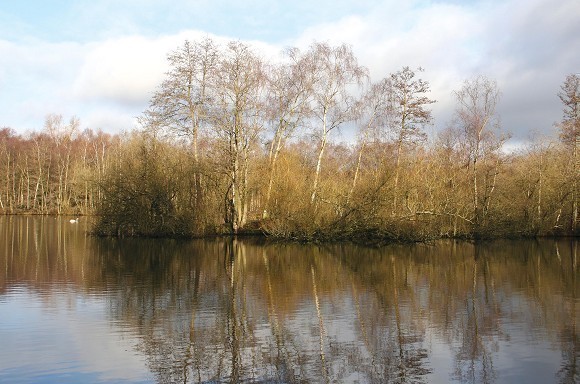 Where would you put your bait? Strangely enough, most of my bites came from the open water on the left and not the alcove which begs a lead
Where would you put your bait? Strangely enough, most of my bites came from the open water on the left and not the alcove which begs a lead“Finally, talking of rigs, does the set-up change much when fishing a bar, gully or ledge?”
“I have said it on more than one occasion there isn’t a rig that suits every lake and situation, so yes. Basically if I was fishing over a steep-sided bar I wouldn’t favour the Chod Rig. Due to the mechanics of the rig working better with a pop-up that is buoyant enough to slide the hooklink up the leadcore I would feel that the given line angle would make my hookbait sit up in the mid-water. So if I felt I wanted to use a pop-up I would go for the Hinge Stiff Rig or an off-the-lead presentation.
“For fishing over tight baiting on hard spots such as the tops of bars or gravel ledges I tend to use a bottom bait, but have been known to catch on single pop-ups or light scattering of freebies. Of course I’m known to be a great fan of the Chod, but it does tend to be better when used on flatter ground, but not necessarily clean bottom as its name suggests.”
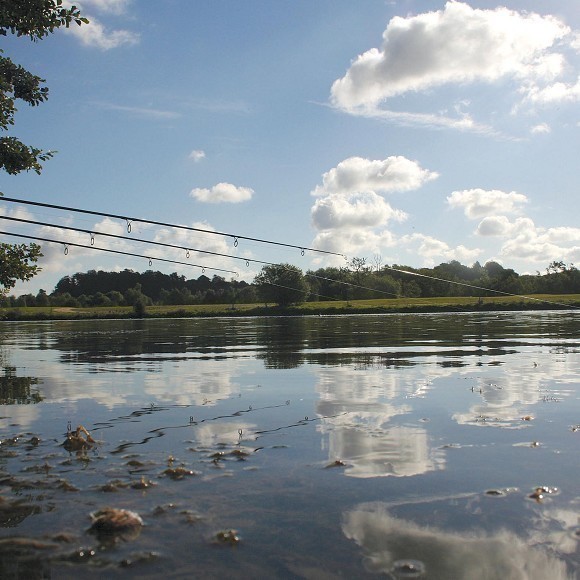 If I was fishing over the back of a bar, then I tend to fish fairly tight lines as it helps conceal it by pinning it against the feature.
If I was fishing over the back of a bar, then I tend to fish fairly tight lines as it helps conceal it by pinning it against the feature.




